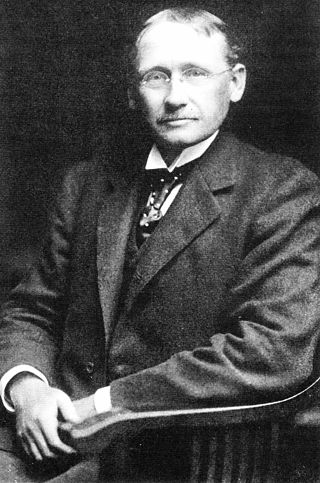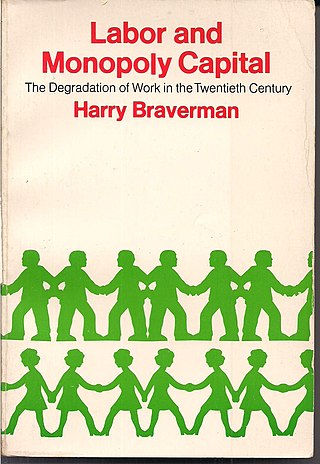Related Research Articles

Industrial sociology, until recently a crucial research area within the field of sociology of work, examines "the direction and implications of trends in technological change, globalization, labour markets, work organization, managerial practices and employment relations" to "the extent to which these trends are intimately related to changing patterns of inequality in modern societies and to the changing experiences of individuals and families", and " the ways in which workers challenge, resist and make their own contributions to the patterning of work and shaping of work institutions".
Human resources (HR) is the set of people who make up the workforce of an organization, business sector, industry, or economy. A narrower concept is human capital, the knowledge and skills which the individuals command. Similar terms include manpower, labor, labor-power, or personnel.

Remote work is the practice of working from one's home or another space rather than from an office.

Scientific management is a theory of management that analyzes and synthesizes workflows. Its main objective is improving economic efficiency, especially labor productivity. It was one of the earliest attempts to apply science to the engineering of processes to management. Scientific management is sometimes known as Taylorism after its pioneer, Frederick Winslow Taylor.
An organizational structure defines how activities such as task allocation, coordination, and supervision are directed toward the achievement of organizational aims.

Occupational hygiene is the anticipation, recognition, evaluation, control, and confirmation (ARECC) of protection from risks associated with exposures to hazards in, or arising from, the workplace that may result in injury, illness, impairment, or affect the well-being of workers and members of the community. These hazards or stressors are typically divided into the categories biological, chemical, physical, ergonomic and psychosocial. The risk of a health effect from a given stressor is a function of the hazard multiplied by the exposure to the individual or group. For chemicals, the hazard can be understood by the dose response profile most often based on toxicological studies or models. Occupational hygienists work closely with toxicologists for understanding chemical hazards, physicists for physical hazards, and physicians and microbiologists for biological hazards. Environmental and occupational hygienists are considered experts in exposure science and exposure risk management. Depending on an individual's type of job, a hygienist will apply their exposure science expertise for the protection of workers, consumers and/or communities.
Human resource management is the strategic and coherent approach to the effective and efficient management of people in a company or organization such that they help their business gain a competitive advantage. It is designed to maximize employee performance in service of an employer's strategic objectives. Human resource management is primarily concerned with the management of people within organizations, focusing on policies and systems. HR departments are responsible for overseeing employee-benefits design, employee recruitment, training and development, performance appraisal, and reward management, such as managing pay and employee benefits systems. HR also concerns itself with organizational change and industrial relations, or the balancing of organizational practices with requirements arising from collective bargaining and governmental laws.
Personnel economics has been defined as "the application of economic and mathematical approaches and econometric and statistical methods to traditional questions in human resources management". It is an area of applied micro labor economics, but there are a few key distinctions. One distinction, not always clearcut, is that studies in personnel economics deal with the personnel management within firms, and thus internal labor markets, while those in labor economics deal with labor markets as such, whether external or internal. In addition, personnel economics deals with issues related to both managerial-supervisory and non-supervisory workers.

Workforce productivity is the amount of goods and services that a group of workers produce in a given amount of time. It is one of several types of productivity that economists measure. Workforce productivity, often referred to as labor productivity, is a measure for an organisation or company, a process, an industry, or a country.
Employee monitoring software is a means of employee monitoring, and allows company administrators to monitor and supervise all their employee computers from a central location. It is normally deployed over a business network and allows for easy centralized log viewing via one central networked PC. Sometimes, companies opt to monitor their employees using remote desktop software instead.
A workplace is a location where someone works, for their employer or themselves, a place of employment. Such a place can range from a home office to a large office building or factory. For industrialized societies, the workplace is one of the most important social spaces other than the home, constituting "a central concept for several entities: the worker and [their] family, the employing organization, the customers of the organization, and the society as a whole". The development of new communication technologies has led to the development of the virtual workplace and remote work.
Workplace privacy is related with various ways of accessing, controlling, and monitoring employees' information in a working environment. Employees typically must relinquish some of their privacy while in the workplace, but how much they must do can be a contentious issue. The debate rages on as to whether it is moral, ethical and legal for employers to monitor the actions of their employees. Employers believe that monitoring is necessary both to discourage illicit activity and to limit liability. With this problem of monitoring employees, many are experiencing a negative effect on emotional and physical stress including fatigue, lowered employee morale and lack of motivation within the workplace. Employers might choose to monitor employee activities using surveillance cameras, or may wish to record employees activities while using company-owned computers or telephones. Courts are finding that disputes between workplace privacy and freedom are being complicated with the advancement of technology as traditional rules that govern areas of privacy law are debatable and becoming less important.
Employee monitoring is the surveillance of workers' activity. Organizations engage in employee monitoring for different reasons such as to track performance, to avoid legal liability, to protect trade secrets, and to address other security concerns. This practice may impact employee satisfaction due to its impact on the employee's privacy. Among organizations, the extent and methods of employee monitoring differ.

Labor and Monopoly Capital: The Degradation of Work in the Twentieth Century is a book about the economics and sociology of work under monopoly capitalism by the political economist Harry Braverman. Building on Monopoly Capital by Paul A. Baran and Paul Sweezy, it was first published in 1974 by Monthly Review Press.
Computer surveillance in the workplace is the use of computers to monitor activity in a workplace. Computer monitoring is a method of collecting performance data which employers obtain through digitalised employee monitoring. Computer surveillance may nowadays be used alongside traditional security applications, such as closed-circuit television.
Organizational technoethics (OT) is a branch stemming from technoethics. Advances in technology and their ability to transmit vast amounts of information in a short amount of time have changed the way information is being shared amongst co-workers and managers throughout organizations across the globe. Starting in the 1980s with information and communications technologies (ICTs), organizations have seen an increase in the amount of technology that they rely on to communicate within and outside of the workplace. However, these implementations of technology in the workplace create various ethical concerns and in turn a need for further analysis of technology in organizations. As a result of this growing trend, a subsection of technoethics known as organizational technoethics has emerged to address these issues.
Corporate surveillance describes the practice of businesses monitoring and extracting information from their users, clients, or staff. This information may consist of online browsing history, email correspondence, phone calls, location data, and other private details. Acts of corporate surveillance frequently look to boost results, detect potential security problems, or adjust advertising strategies. These practices have been criticized for violating ethical standards and invading personal privacy. Critics and privacy activists have called for businesses to incorporate rules and transparency surrounding their monitoring methods to ensure they are not misusing their position of authority or breaching regulatory standards.

The impact of artificial intelligence on workers includes both applications to improve worker safety and health, and potential hazards that must be controlled.
Indiscriminate monitoring is the mass monitoring of individuals or groups without the careful judgement of wrong-doing. This form of monitoring could be done by government agencies, employers, and retailers. Indiscriminate monitoring uses tools such as email monitoring, telephone tapping, geo-locations, health monitoring to monitor private lives. Organizations that conduct indiscriminate monitoring may also use surveillance technologies to collect large amounts of data that could violate privacy laws or regulations. These practices could impact individuals emotionally, mentally, and globally. The government has also issued various protections to protect against indiscriminate monitoring.
Algorithmic management is a term used to describe certain labor management practices in the contemporary digital economy. In scholarly uses, the term was initially coined in 2015 by Min Kyung Lee, Daniel Kusbit, Evan Metsky, and Laura Dabbish to describe the managerial role played by algorithms on the Uber and Lyft platforms, but has since been taken up by other scholars to describe more generally the managerial and organisational characteristics of platform economies. However, digital direction of labor was present in manufacturing already since the 1970s and algorithmic management is becoming increasingly widespread across a wide range of industries.
References
- ↑ Lund, J., & Wright, C. (2001). State Regulation and the New Taylorism: The Case of Australian Grocery Warehousing. Relations Industrielles, 56(4), 747–767
- ↑ Au, W. (2011). Teaching under the new Taylorism: high-stakes testing and the standardization of the 21st century curriculum. Journal of Curriculum Studies, 43(1), 25–45
- ↑ Parenti, C. (2001). Big brother's corporate cousin: high-tech workplace surveillance is the hallmark of a new digital Taylorism. The Nation, 273(5), 26–30
- ↑ Lanigan, Charles. "From Assembly Line to Just-in-Time: Preparing a Capable Workforce for the Knowledge Economy". CIO. Retrieved 18 May 2015.
- ↑ Wood, S. (1987). "The Deskilling Debate, New Technology and Work Organization". Acta Sociologica (Taylor & Francis Ltd), 30(1), 3–24
- ↑ Parenti, C. (2001). Big brother's corporate cousin: high-tech workplace surveillance is the hallmark of a new digital Taylorism. The Nation, 273(5), 26–30
- ↑ Au, W. (2011). Teaching under the new Taylorism: high-stakes testing and the standardization of the 21st century curriculum. Journal of Curriculum Studies, 43(1), 25-45
- ↑ Limitations in "Digital Taylorism": Applying Semiotics to Human-Computer Interaction Research (password required)